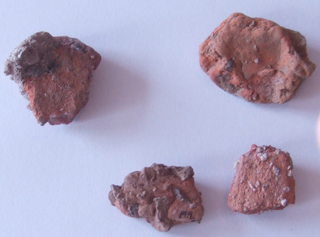
Briquetage and Cheshire Salt Containers

Briquetage is the term used for coarse ceramic salt drying and transporting containers used in the later Iron Age and Romano-British period. A number of sherds of these vessels have been found on the site, probably from the Middlewich area of Cheshire, which give us fascinating information about trade networks and contact during this period.
Dr. Elaine L. Morris of the University of Southampton examined pottery fragments from the site and the following is an edited extract from her report:
A total of twenty one sherds (63 grams) of briquetage, salt-drying and transporting containers from Cheshire were identified in the ceramic assemblage. This particular type of briquetage, originally named Stony VCP or a stone-gritted Very Coarse Pottery, is quite distinctive due to the oxidised firing condition resulting in an orange coloured clay matrix and the prersence of large angular fragments of igneous and sedimentary rock in the fabric.
Sherds of Cheshire salt containers were recovered from ten contexts in four different trenches at Mellor. The fragmentary nature of the material is demonstrated by the very small, mean sherd weight of the assemblage as a whole at 3 grammes, which also shows the quality of the excavation recovery techniques on site - these are very, very tiny fragments in many cases. Only body sherds and flakes of briquetage containers were recovered.
The presence of this Cheshire briquetage at Mellor has increased the northern distribution to 35km from Central Cheshire. Middlewich is most likely to be the source for this Iron Age salt production because of the presence of Roman saltworking at this location, but prehistoric salt production evidence has yet to be found at any of the famous salt towns in Cheshire. The earliest, well dated deposits indicate that this material was not in use at the site during the Late Bronze Age but was present during the aceramic Early Iron Age. The latest use of these of these containers for salt transportation appears to be in the early Roman period.
The distribution of salt in distinctive containers demonstrates the extensive networks of exchange present during the second half ot the first millenium BC in Britain. Salt would have been required for a variety of preservation uses, such as in salting meat, making cheese and preserving hides. There is always the possibility that it's value may have been similar to a type of early currency, in the absence of coinage, and it could have been employed as a form of bridewealth amongst Iron Age tribal groups.
It has recently been suggested that saltmakers may even have been seen as early alchemists with a magical aura as they produced this strange white crystalline substance from bitter, brackish water.
With Thanks to Dr Elaine Morris
